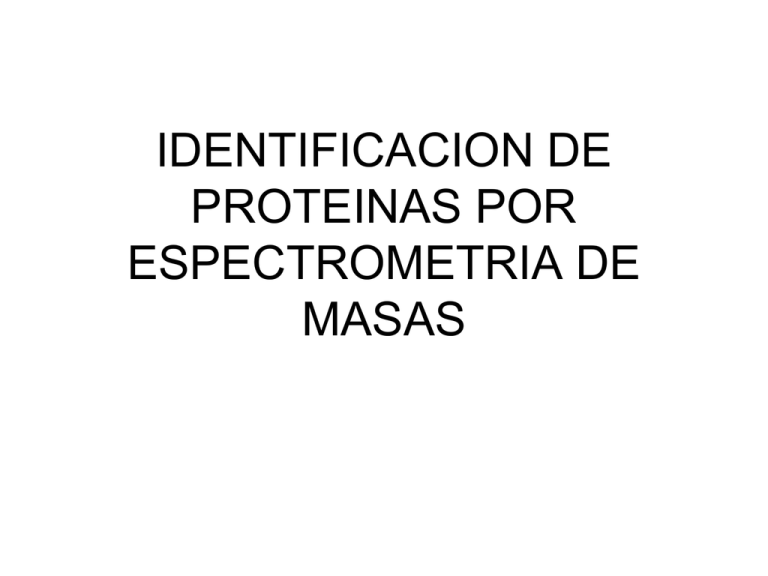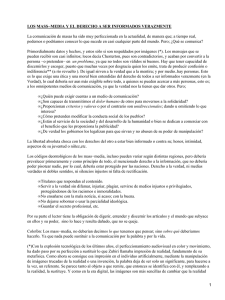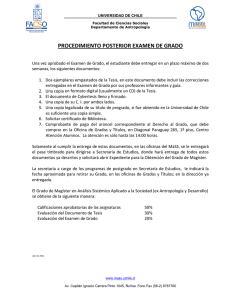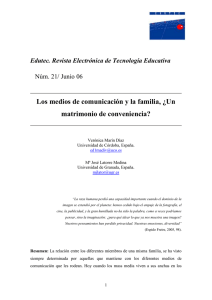identificacion de proteinas por espectrometria de masas
Anuncio

IDENTIFICACION DE PROTEINAS POR ESPECTROMETRIA DE MASAS MAPEO PEPTIDICO MALDI-TOF Laser Source Reflector detector Reflector Linear detector Intensidad MALDI-TOF PEPTIDE MAP 14000 12000 10000 8000 6000 4000 2000 0 1000 1500 2000 m/z 2500 3000 LISTA DE MASAS (M+H)+ MALDI –TOF 784.3418140 842.5959093 980.5626285 1035.9943063 1223.0031412 1320.6705505 1383.8862641 1443.9027243 1478.7756116 1618.9662799 1853.9439990 1992.0078070 2211.1351764 2352.2265273 2452.1348603 2940.5052161 786.3842737 868.0212272 995.4804915 1104.5739910 1257.7214116 1336.7215360 1400.8334328 1444.8573056 1515.8095976 1640.8552052 1868.9176883 2004.9713883 2234.1502183 2374.1764475 2586.1954157 2961.3846998 791.3324814 920.5367162 1002.5186292 1117.5859942 1292.7490503 1378.6730204 1417.7440014 1452.8004541 1537.7994285 1695.8955553 1890.8955786 2013.9972541 2280.1405386 2407.1505476 2907.3866417 2977.3692220 802.4655264 930.5019057 1030.0570454 1157.5212345 1298.6645031 1380.8192125 1439.7449235 1475.8468711 1557.8880162 1711.8939706 1972.0409239 2105.0723419 2348.2985678 2429.2204631 2929.3468854 3084.3946593 Database Searching with Peptide Mass fingerprints • Produce a theoretical digest of all the proteins in a database with a specific enzyme • Compare these theoretical masses with experimentally observed masses • Assign a score to matching peptides/proteins Peptide mass fingerprinting = PMF MS database matching Protein(s) Enzymatic digestion Peptides Mass spectra Peaklist 840.695086 1676.96063 1498.8283 1045.564 2171.967066 861.107346 842.51458 1456.727405 863.268365 Match …MAIILAGGHSVRFGPKAF AEVNGETFYSRVITLESTNM FNEIIISTNAQLATQFKYPN VVIDDENHNDKGPLAGIYTI MKQHPEEELFFVVSVDTPMI TGKAVSTLYQFLV … Sequence database entry In-silico digestion - MAIILAGGHSVR - FGPK - AFAEVNGETFYSR - VITLESTNMFNEIIISTNAQLATQFK - YPNVVIDDENHNDK … Theoretical proteolytic peptides 861.107346 838.695086 1676.96063 1498.8283 1045.564 2171.967066 842.51458 1457.827405 863.268453 Theoretical peaklist Result: ranked list of protein candidates Experimental obtained Peak List 578.4650 759.4258 823.5573 842.4996 847.4735 958.4569 1045.5183 1073.5519 1179.5375 1234.6153 1277.6628 1307.6242 1319.6409 1393.7345 1435.6503 1458.6973 1475.6994 1607.8008 1638.8254 1702.7632 1708.8902 1881.9862 1891.9032 1947.9970 1993.9588 2036.9506 2065.9937 2191.1330 2211.0996 2249.0684 2284.1556 2403.2098 2705.1716 2717.1385 2754.3835 2807.3473 3340.7427 3810.9065 Theoretical obtained Peak Lists (database) Comparison 739.4523 578.4650 578.465 1039.6412 578.4650 759.4258 759.425 1045.6026 759.4258 823.5573 823.557 1130.6069 823.5573 842.4996 842.499 1153.6036 842.4996 847.4735 847.473 1173.6547 847.4735 958.4569 958.456 1216.6140 958.4569 1045.5183 1045.518 1277.7128 1045.5183 1073.5519 1073.551 1331.7125 1073.5519 1179.5375 1179.537 1377.7807 1179.5375 1234.6153 1234.615 1427.7627 1234.6153 1277.6628 1277.662 1467.8732 1277.6628 1307.6242 1307.624 1475.8187 1307.6242 1319.6409 1319.640 1501.7571 1319.6409 1393.7345 1393.734 1519.7985 1393.7345 1435.6503 1435.650 1532.7814 1435.6503 1458.6973 1458.697 1583.8208 1458.6973 1475.6994 1475.699 1623.8369 1475.6994 1607.8008 1607.800 1629.8832 1607.8008 1638.8254 1638.825 1639.9686 1638.8254 1702.7632 1702.763 1645.8650 1702.7632 1708.8902 1708.890 1699.9806 1708.8902 1881.9862 1881.982 1719.0006 1881.9862 1891.9032 1891.903 1752.8911 1891.9032 1947.9970 1947.997 1775.8374 1947.9970 1993.9588 1993.958 1790.9179 1993.9588 2036.9506 2036.950 1850.9461 2036.9506 2065.9937 2065.993 1924.9963 2065.9937 2191.1330 2191.133 1959.0290 2191.1330 2211.0996 2211.099 1982.0410 2211.0996 2249.0684 2249.068 1993.9696 2249.0684 2284.1556 2284.155 2063.0936 2284.1556 2403.2098 2403.209 2126.0578 2403.2098 2705.1716 2705.171 2225.1160 2705.1716 2717.1385 2717.135 2230.1678 2717.1385 2754.3835 2754.383 2284.1491 2754.3835 2807.3473 2807.347 2298.1760 2807.3473 3340.7427 3340.742 2469.1638 3340.7427 3810.9065 3810.906 3810.9065 QUÉ ES NECESARIO PARA REALIZAR UN MAPEO PEPTÍDICO (PMF, Peptide Mass Fingerprinting) • ESPECTROMETRIA DE MASAS QUE SEA ADECUADA PARA PEPTIDOS>>>> METODOS DE IONIZACION SUAVES>>> MALDI o ESI. EN APARATOS COMERCIALES A PRINCIPIO DE LOS AÑOS 90 • BASES DE DATOS PUESTAS AL DIA CON EL MAYOR NUMERO POSIBLE DE ENTRADAS: 20,000 en1989; 5.6x106 en Diciembre 2007 • PROGRAMAS DE COMPARACION; LOS PRIMEROS APARECIERON EN 1993 Summary of PMF tools Tool Source website Aldente www.expasy.org/cgi-bin/aldente Mascot www.matrixscience.com/ MS-Fit prospector.ucsf.edu/ ProFound prowl.rockefeller.edu/profound_bin/WebProFound.exe PepMAPPER wolf.bms.umist.ac.uk/mapper/ PeptideSearch www.mann.emblheidelberg.de/GroupPages/PageLink/peptidesearchpage.html PepFrag prowl.rockefeller.edu/prowl/pepfragch.html Non exhaustive list! http://www.expasy.org/tools/ http://www.matrixscience.com/ • • Mascot Search Peptide Mass Fingerprint: The experimental data are a list of peptide mass values from an enzymatic digest of a protein. – Example of results report – More information • Sequence Query: One or more peptide mass values associated with information such as partial or ambiguous sequence strings, amino acid composition information, MS/MS fragment ion masses, etc. A super-set of a sequence tag query. – Example of results report – More information • MS/MS Ion Search: Identification based on raw MS/MS data from one or more peptides. – Example of results report – More information • Search Form Defaults: Follow this link to save your preferred search form defaults as a browser cookie. • Useful Links • Protein Identification & Characterisation • Lutefisk97 – Rich Johnson's de novo sequence program • MassSearch – Computational Biochemistry Research Group, ETH, Zurich • (e)Mowse – The original Mowse was developed at the Imperial Cancer Research Fund, London, but has now disappeared from the web • MultiIdent, PeptIdent, and TagIdent – Swiss Institute of Bioinformatics, Geneva • PepNovo – De novo sequence interpretation from UCSD • PeptideSearch – Protein and Peptide Group, EMBL, Heidelberg • Protein Prospector – Mass Spectrometry Facility, UCSF, San Francisco • Prowl – Rockefeller University, New York • Sashimi / Trans-Proteomic Pipeline – Seattle Proteome Center proteomics tools • Sequest – Scripps Research Institute, La Jolla Peptide Mass Fingerprinting A mass spectrum of the peptide mixture resulting from the digestion of a protein by a proteolytic enzyme • • • • • • • Choice of Enzyme Missed Cleavages Search Masses Constraining the Protein Molecular Weight Which masses to include in a search Autolysis products Modifications Choice of Enzyme • Enzymes of low specificity are next to useless as they produce a complex mixture of similar masses • For MALDI, Peptides of masses less than 500 Da should be avoided Digestion using trypsin N R KR N R K RP C C N Missed cleavage sites Missed Cleavages • Digests are usually not perfect • Cleavage sites may be missed by an enzyme • These partially cleaved peptides are known as partials • Reduce the discrimination of a search Search Masses • Select masses which are large enough to provide discrimination • Larger masses are more likely to be partials • With Trypsin, a mass range of 1000 to 3000 Da is good • Mass tolerance is important in obtaining good discrimination Removal of contaminants Common contaminants •Keratin •Tryptic autodigest projects (842.5, 2211.1) Keratin1 873.50 1 Da Keratin1 Keratin9 Keratin9 Intensity 871.94 Keratin1 Keratin1 Keratin9 Keratin9 3.50 Keratin1 973.43 Intensity 60 Keratin1 1179.5 Keratin9 Keratin1 Keratin1 Keratin1 •Matrix-clusters 0 871.0 m/z 876.0 C:\Documents and Settings\Administrator\Desktop\matrix-sample.massml (13:05 01/15/02) Description: FLEXControl generated XMASS data (c) 2000 Bruker Daltonics 0 500 m/z 4000 C:\Documents and Settings\Administrator\Desktop\keratinrigtspectra.massml (10:52 01/15/02) Description: Yeast Overlapping matrix (871.94) and peptide (873.50) peaks. 842.42 1993.7 1851.7 1837.7 1818.7 1794.6 1765.5 1759.7 1707.61715.6 1657.6 1307.5 1523.6 1503.6 1434.6 1384.6 1323.5 1320.4 1280.6 1251.6 1234.5 1179.5 1082.5 1045.5 1036.4 875.36 830.37870.44 \\Bmb-filsrv\PRpublic\IngerMZ\PH0508\p54731ic, plug 3.massml (11:21 03/15/05) Description: PH0508, Ag-plug 3 <3355.2> 3338.3 3324.3 3677.4 3662.3 3819.6 Identification of contaminants 3146.2 3050.9 2932.1 2901.2 2872.0 2822.0 2807.0 2790.1 2716.7 2748.1 2704.8 2644.0 2589.9 2583.9 2565.9 2509.8 2500.9 2444.9 2398.7 2383.6 2342.7 2283.9 2234.9 2224.8 2202.9 2185.9 2183.8 2149.8 2210.8 1638.7 5000 m/z 1000 1475.6 1267.6 Intensity 0 Taking advantage of contaminants! 25 < 20 ppm Multipoint calibration on contaminants Outlier Constraining Protein Mass • To increase discrimination, the mass of the intact protein can be used in a search • This is dangerous since this may be just a fragment of an entire protein Which Masses to Include ? The optimum dataset for a peptide mass fingerprint is all the correct peptides and none of the wrong ones ! By correct, we mean that the textbook cleavage rules were followed. In practice, this rarely (if ever) happens. • Enzymatic cleavage not perfect • Sequence coverage may be poor • Noise Parámetros de búsqueda: BASES DE DATOS Parámetros de búsqueda: TAXONOMÍA Parámetros de búsqueda: ENZIMA Don't cleave Name Cleave Trypsin KR P CTERM Arg-C R P CTERM Asp-N BD NTERM Asp-N_ambic DE NTERM Chymotrypsin FYWL CNBr M CTERM Formic_acid D CTERM Lys-C K Lys-C/P K CTERM PepsinA FL CTERM Tryp-CNBr KRM P CTERM TrypChymo FYWLKR P CTERM Trypsin/P KR V8-DE BDEZ P CTERM V8-E EZ P CTERM CNBr+Trypsin P P CTERM CTERM CTERM M KR N or C term CTERM P CTERM Parámetros de búsqueda: MISSED CLEAVAGES ¡! Es conveniente no especificar más de 2 cortes parciales ya que el aumento supone incrementar el número de péptidos a los que se enfrentarán los datos experimentales con lo cual: Aumenta el tiempo de búsqueda Aumenta el número de asignaciones aleatorias Disminuye la discriminación y la puntuación final Parámetros de búsqueda: MODIFICACIONES Parámetros de búsqueda: MODIFICACIONES FIJAS • Modificación aplicada universalmente • No produce aumento en el número de péptidos Ej. Carbamidomethyl (C) + 57 Da C 103 Da 160 Da VARIABLES • Modificación que puede o no estar presente • Se buscan todas las posibles combinaciones para encontrar la mejor asignación Ej. Oxidation (M) + 16 Da AIMCTHDMEYWMK AIMCTHDMEYWMK AIMCTHDMEYWMK AIMCTHDMEYWMK AIMCTHDMEYWMK AIMCTHDMEYWMK AIMCTHDMEYWMK AIMCTHDMEYWMK ¡! • Cada modif. variable puede generar varios péptidos adicionales para ser testados: Aumenta el tiempo de búsqueda Aumenta el número de asignaciones aleatorias Disminuye la discriminación y la puntuación final Parámetros de búsqueda: TOLERANCIA DE LOS PÉPTIDOS Es el margen de error permitido para las masas experimentales de los péptidos Parámetros de búsqueda: TOLERANCIA DE LOS PÉPTIDOS Unidades: % fracción expresada como porcentaje mmu medida absoluta en milésimas de Da Da ppm unidades absolutas en Da fracción expresada como partes por millón búsqueda de un péptido de 1000.00 Da 100 ppm se busca entre 999.90 Da y 1000.10 Da La tolerancia permitida dependerá de la exactitud de masa del equipo y del calibrado exactitud tolerancia probabilidad buena asignación Data about experimental conditions • Accepted mass tolerance due to imprecise measures and calibration problems Result 1 51 101 151 201 1891.9 251 301 351 401 451 501 551 601 2037.0 2191.1 651 701 1882.0 18 1319.6 Contaminants Intensity 1475.7 1307.6 MSEQLRQTFA LGMPFSDPIA MGYYNPILNY LIPLVAPSTT VRKYTKDTPL YDVAKEYVQG KHPIRFGDFG RPSSLHKAER KNVIAETGAG AKVIAVTNGT FQSVIGKETK LGVEAGGDGV GLDYPGVGPE HAVYGACELA FEEDPSA NAKKENRNAL DGPTIQLSNT GEERFIQDAA DERLELLSHI AVGFGVSTRE ILNGAKHKVL GQYVPEALHA LTEHCQGAQI QHGVATATAC KTLRDATSEA EQFAAMNNGK DTKFHSATLT LAYWKSTGRA KTMKPDQHLV VTFMTAGYPT VALQNGVTLP KAGANGFIIV ADSFVYVVSR HFQSVGSVAD SKDEFFAFQK CLRELEKGFD WLKREDLNHT AKFGLTCTVF FRFWVTNLKT LPDAVVACVG AGRPGVFHGV QFIAATDAQA INISGRGDKD VKDTVPILKG QTLEMVSQAR DLPPEEALKV MGTTGVQSSV GVVIGSKIVT ESLKSANVKK EAVADPTFWE GSHKINNALA MGAEDVRRQA TYYVVGSAIG GGSNSTGMFS KTYVLQDSDG LLGFKLLSQL VQSVAEVLPK 1708.9 2066.0 2211.1 1393.7 842.50 1277.7 1179.5 1994.0 1435.7 1607.8 1458.7 1702.8 1948.0 958.46 1045.5 1073.6 1234.6 847.47 759.43 823.56 578.47 1638.8 2284.2 2403.2 2249.1 Tryptic auto digest 2705.2 2754.4 2717.1 2807.3 <3340.7> <3810.9> 0 500 m/z 4000 FQDGGVDIIE NEGVTVPIIL RNYINDNGLS ASDLDELISR LCGDAPEGKR EILDEFDENH DFKSLYSYIG QVLLAKRLGK LNVFRMRILG PHPYPTLVRT PFEHDTSVKL QVHDTHSVSA EGIIPALESS LGPKIGWDLR Interpretación de los Resultados He identificado una proteína pero... ¿Es realmente correcta la identificación? Análisis cuidadoso de los resultados Del total de masas experimentales, ¿cuántas “encajan” con la proteína? Las masas asignadas a la proteína, ¿son las más abundantes del espectro? ¿Cuánto se aleja nuestro resultado de la zona de incertidumbre? Coincidencia del resultado empleando distintos motores de búsqueda Coincidencia del resultado haciendo la digestión con distintas proteasas Ventajas y Limitaciones del PMF VENTAJAS Análisis rápido y con bajo coste Alta sensibilidad Aplicable a un elevado número de muestras LIMITACIONES La proteína debe estar en la DB o presentar un alto grado de homología con proteínas presentes para poder ser identificada No aplicable para proteínas menores de 10 kDa o proteínas con alto número de modificaciones Difícil identificación de mezclas de proteínas



